Analysis of Arctic Sea Ice Concentration Anomalies Using Spatiotemporal Clustering
Abstract
1. Introduction
2. Materials and Methods
2.1. SIC Data
2.2. Methods
2.2.1. Trend Analysis
2.2.2. Spatiotemporal Clustering
- (1)
- Directly density-reachable.
- (2)
- Density-reachable.
- (3)
- Core object.
- (4)
- Border object.
- (1)
- The algorithm starts from the first object o1 in the dataset D.
- (2)
- After processing object o1, the algorithm selects the next object o2. If o2 does not belong to any cluster, the Retrieve_Neighbours function is called.
- (3)
- The function Retrieve_Neighbours(o2, Eps1, Eps2) returns objects within a distance less than that of Eps1 and Eps2 for object o2.
- (4)
- If the function returns fewer objects than Minpts, object o2 is defined as noise, as it does not have enough neighboring points to form a cluster.
- (5)
- Objects that have been labeled as noise may change in the next iteration if they are density-reachable from other objects in D. This change typically occurs at the bounder objects of clustered clusters. If oi is a core object, a new cluster is created.
- (6)
- All objects that are directly density-reachable from these core objects are also labeled with cluster tags. The algorithm uses stack-based iteration to gather density-reachable objects.
- (7)
- If an object is not labeled as noise or assigned to another cluster, and the difference between the mean of the current cluster and the new value is less than or equal to Δε, then it is labeled as part of the current cluster. After processing the current object, the algorithm selects the next object in D and repeats the above process until all objects are processed.
2.2.3. Cluster Validity
3. Results and Discussion
3.1. Determination of Key Areas and Hyperparameters
3.2. Spatiotemporal Clustering Patterns of SIC Anomalies
- (1)
- Origin State.
- (2)
- Development State.
- (3)
- Dissipation State.
- (4)
- Merge State.
- (5)
- Split State.
- (6)
- Merge–Split State.
3.3. Spatial Transformation Characteristics of SIC Anomaly Evolution
4. Conclusions
Author Contributions
Funding
Institutional Review Board Statement
Informed Consent Statement
Data Availability Statement
Conflicts of Interest
References
- Wang, Z.; Li, Z.; Zeng, J.; Liang, S.; Zhang, P.; Tang, P.; Chen, S.; Ma, X. Spatial and Temporal Variations of Arctic Sea Ice from 2002 to 2017. Earth Space Sci. 2020, 7, e2020EA001278. [Google Scholar] [CrossRef]
- Zhang, P.; Wu, Z.; Jin, R. How can the winter North Atlantic Oscillation influence the early summer precipitation in Northeast Asia: Effect of the Arctic sea ice. Clim. Dyn. 2021, 56, 1989–2005. [Google Scholar] [CrossRef]
- Maksym, T. Arctic and Antarctic Sea Ice Change: Contrasts, Commonalities, and Causes. Annu. Rev. Mar. Sci. 2019, 11, 187–213. [Google Scholar] [CrossRef]
- Lenton, T.M.; Held, H.; Kriegler, E.; Hall, J.W.; Lucht, W.; Rahmstorf, S.; Schellnhuber, H.J. Tipping elements in the Earth’s climate system. Proc. Natl. Acad. Sci. USA 2008, 105, 1786–1793. [Google Scholar] [CrossRef]
- Yang, M.; Qiu, Y.; Huang, L.; Cheng, M.; Chen, J.; Cheng, B.; Jiang, Z. Changes in Sea Surface Temperature and Sea Ice Concentration in the Arctic Ocean over the Past Two Decades. Remote Sens. 2023, 15, 1095. [Google Scholar] [CrossRef]
- Zhang, T.; Huang, J.; Cao, Y.; Wang, L.; Sun, Y.; Yang, L. Spatiotemporal Variation of Sea Ice Concentration in Important Arctic Straits is Heterogeneous. Remote Sens. Technol. Appl. 2019, 34, 1162–1172. (In Chinese) [Google Scholar]
- Pang, X.; Zhang, C.; Ji, Q.; Chen, Y.; Zhen, Z.; Zhu, Y.; Yan, Z. Analysis of sea ice conditions and navigability in the Arctic Northeast Passage during the summer from 2002–2021. Geo-Spat. Inf. Sci. 2023, 26, 465–479. [Google Scholar] [CrossRef]
- Liu, Y.; Pang, X.; Zhao, X.; Su, C.; Ji, Q. Analysis of spatiotemporal variability of sea ice in the Beaufort Sea using passive microwave remote sensing data. Chin. J. Polar Res. 2018, 30, 161–172. (In Chinese) [Google Scholar] [CrossRef]
- Li, X.; Wu, Z.; Li, Y. A link of China warming hiatus with the winter sea ice loss in Barents–Kara Seas. Clim. Dyn. 2019, 53, 2625–2642. [Google Scholar] [CrossRef]
- Sun, J.; Liu, S.; Cohen, J.; Yu, S. Influence and prediction value of Arctic sea ice for spring Eurasian extreme heat events. Commun. Earth Environ. 2022, 3, 172. [Google Scholar] [CrossRef]
- Shen, H.; He, S.; Wang, H. Effect of Summer Arctic Sea Ice on the Reverse August Precipitation Anomaly in Eastern China between 1998 and 2016. J. Clim. 2019, 32, 3389–3407. [Google Scholar] [CrossRef]
- Tschudi, M.A.; Meier, W.N.; Stewart, J.S. An enhancement to sea ice motion and age products at the National Snow and Ice Data Center (NSIDC). Cryosphere 2020, 14, 1519–1536. [Google Scholar] [CrossRef]
- Liu, Q.; Zhang, R.; Wang, Y.; Yan, H.; Hong, M. Daily Prediction of the Arctic Sea Ice Concentration Using Reanalysis Data Based on a Convolutional LSTM Network. J. Mar. Sci. Eng. 2021, 9, 330. [Google Scholar] [CrossRef]
- Pang, X.; Liu, J. Effects of climate changes on the NDVI of vegetation in Asia. Remote Sens. Nat. Resour. 2023, 35, 295–305. (In Chinese) [Google Scholar]
- Birant, D.; Kut, A. ST-DBSCAN: An algorithm for clustering spatial–temporal data. Data Knowl. Eng. 2007, 60, 208–221. [Google Scholar] [CrossRef]
- Iswari, L. Profiling the Spatial and Temporal Properties of Earthquake Occurrences Using ST-DBSCAN Algorithm. In Proceedings of the IEEE 7th International Conference on Information Technology and Digital Applications (ICITDA), Yogyakarta, Indonesia, 4–5 November 2022; pp. 1–8. [Google Scholar] [CrossRef]
- Liu, J.; Xue, C.; He, Y.; Dong, Q.; Kong, F.; Hong, Y. Dual-Constraint Spatiotemporal Clustering Approach for Exploring Marine Anomaly Patterns Using Remote Sensing Products. IEEE J. Sel. Top. Appl. Earth Obs. Remote Sens. 2018, 11, 3963–3976. [Google Scholar] [CrossRef]
- Xie, T.; Zhang, Y.; Chen, C.; Xu, D.; Zhang, X.; Wang, Y.; Zhang, Y. Key processes of sea ice variation and thermodynamic response in the Barents Sea and Kara Sea. Adv. Mar. Sci. 2023, 41, 24–39. (In Chinese) [Google Scholar]
- Pan, Y.; Zhang, Y.; Li, S. Assessment of CMIP models in simulating the relationship between wintertime atmospheric circulation in the Northern Hemisphere and the winter-spring temperature over the Tibetan Plateau. J. Meteorol. Sci. 2022, 42, 440–456. (In Chinese) [Google Scholar]
- Wang, W.; Zhao, J. Accumulation Sea ice concentration and its action on understanding arctic sea ice dramatic change. Adv. Earth Sci. 2014, 29, 712–722. (In Chinese) [Google Scholar]
- Jacox, M.G.; Bograd, S.J.; Hazen, E.L.; Fiechter, J. Sensitivity of the California Current nutrient supply to wind, heat, and remote ocean forcing. Geophys. Res. Lett. 2015, 42, 5950–5957. [Google Scholar] [CrossRef]
- Qi, L.; Xu, Y. Interdecadal variations of Arctic sea ice and its interannual relationship with meteorological elements. Trans. Atmos. Sci. 2018, 41, 355–366. (In Chinese) [Google Scholar] [CrossRef]
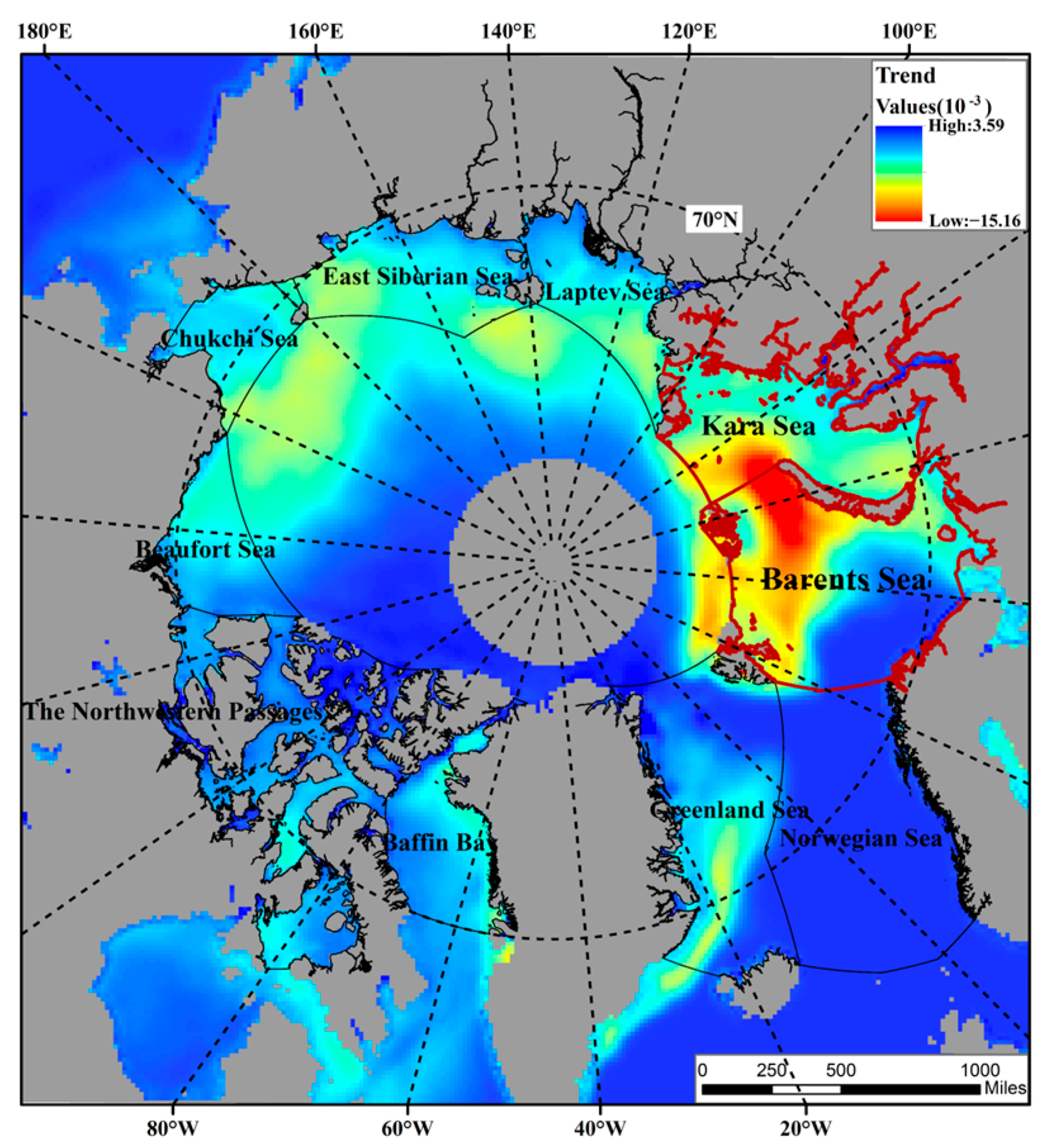

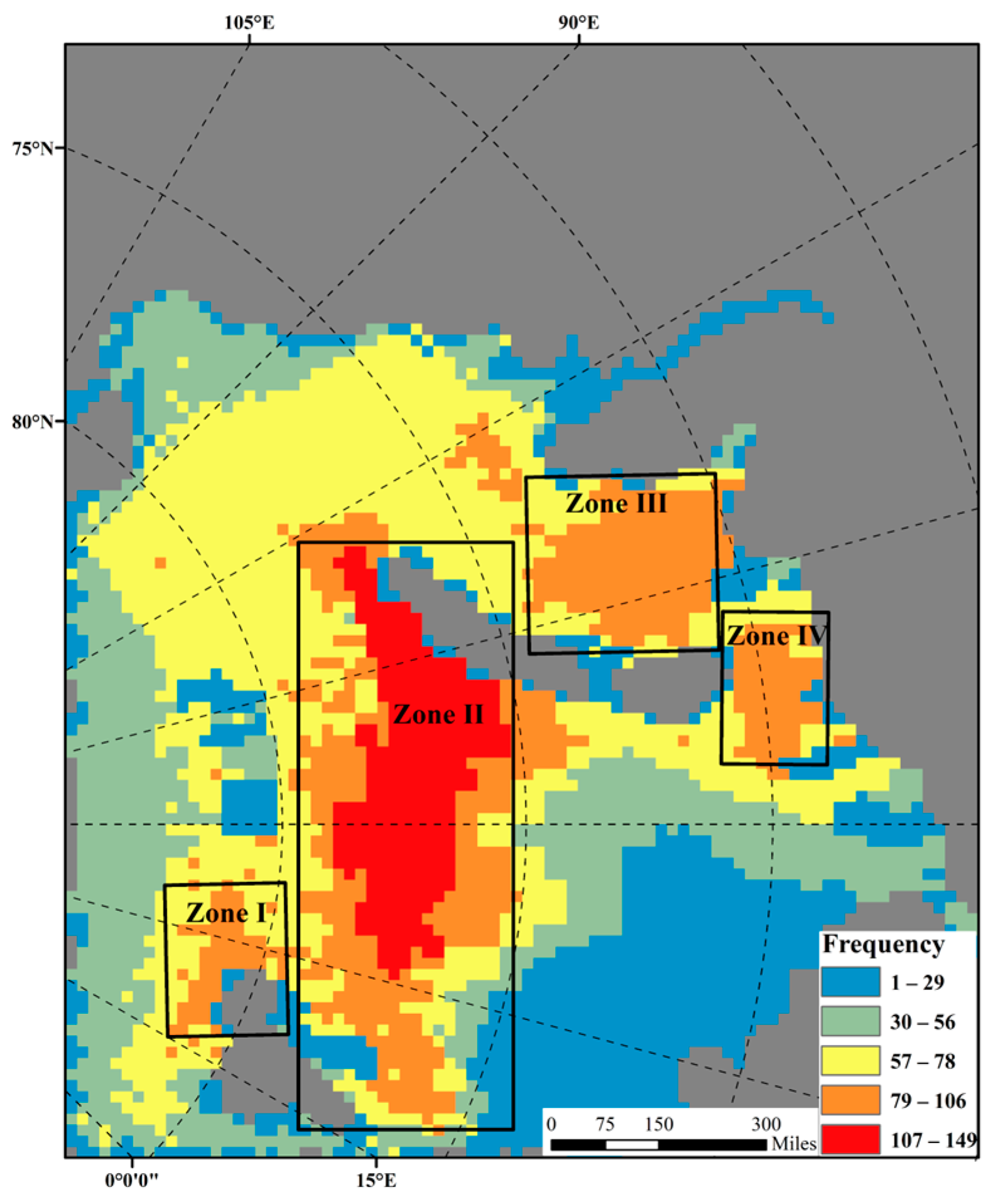
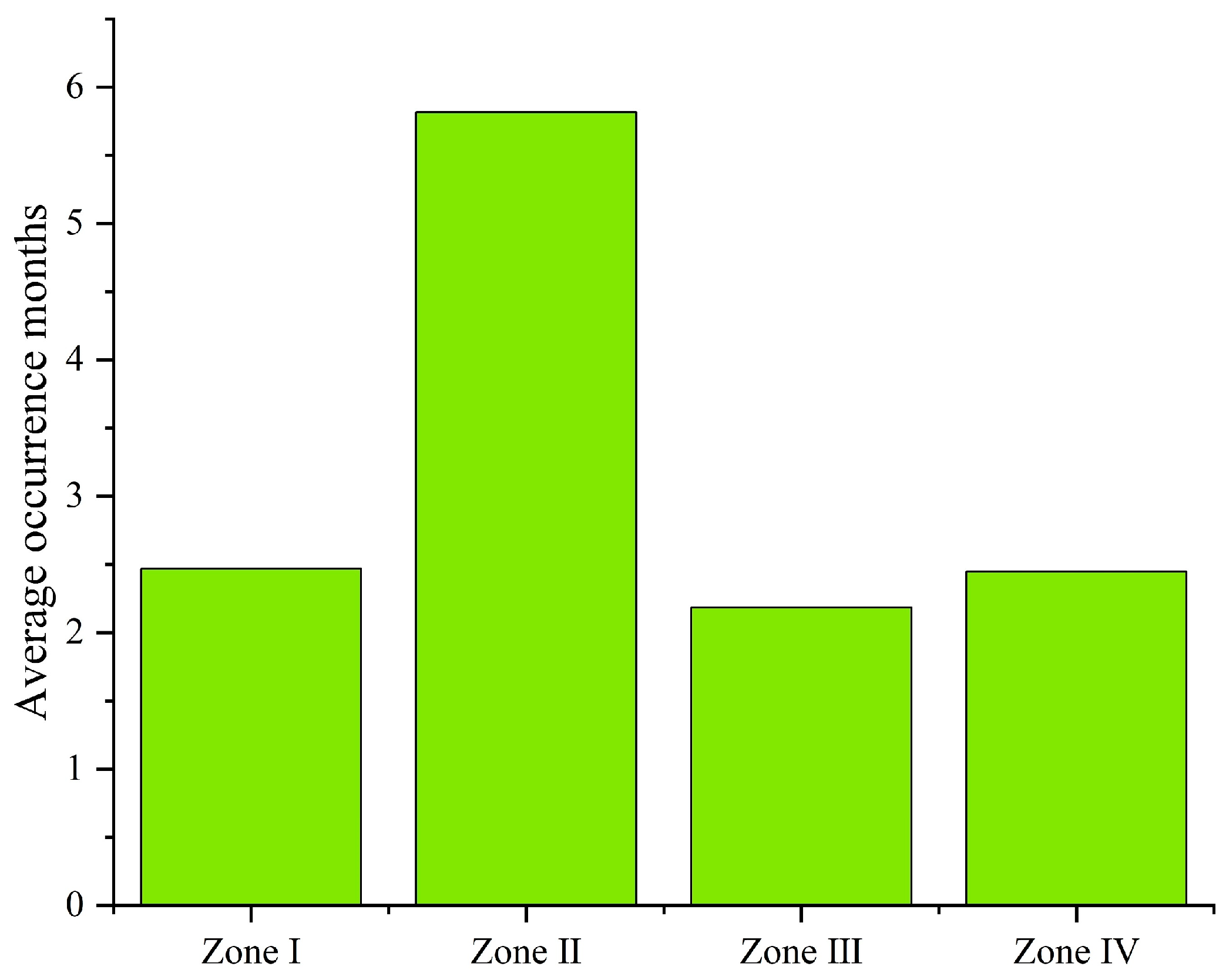

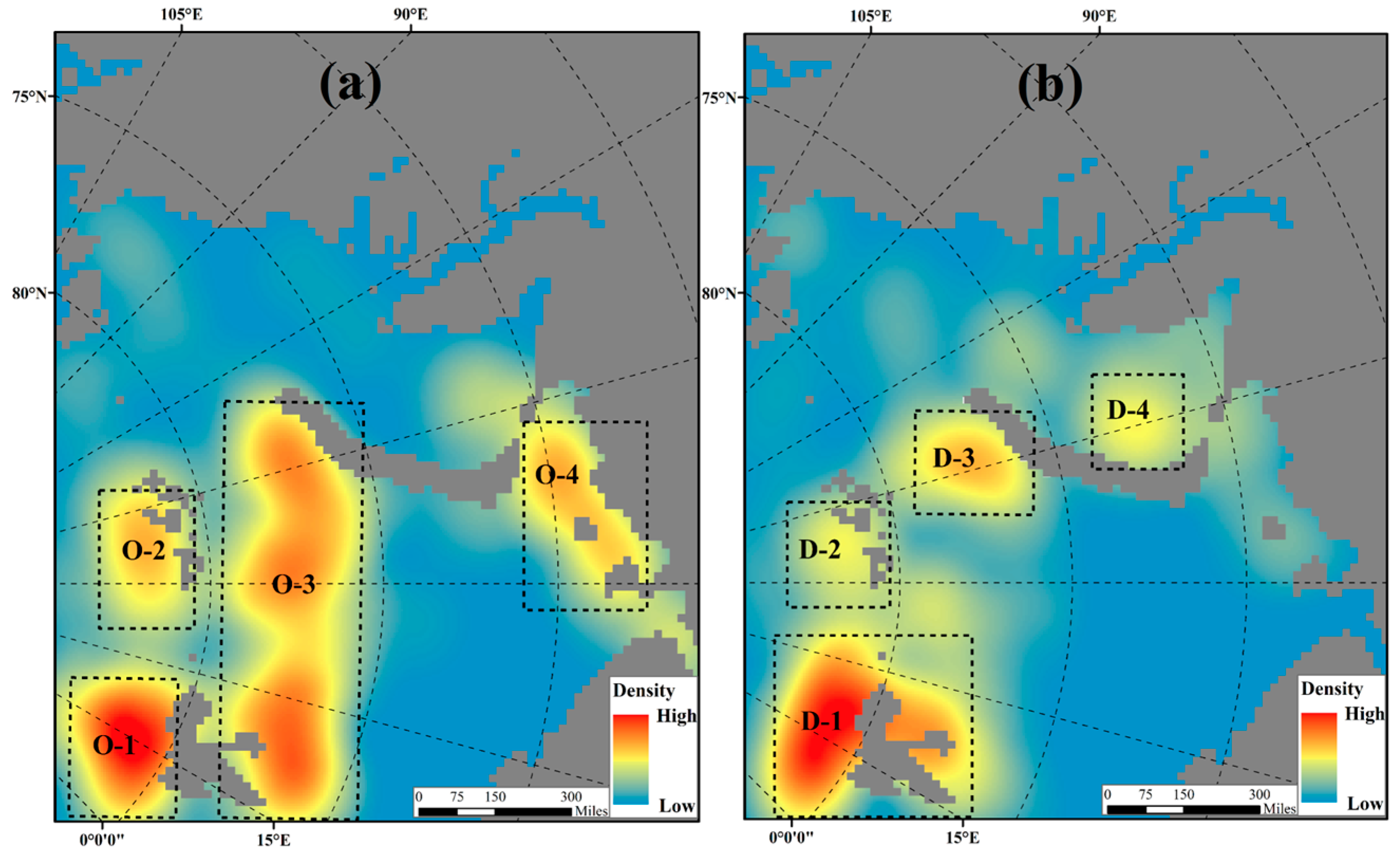
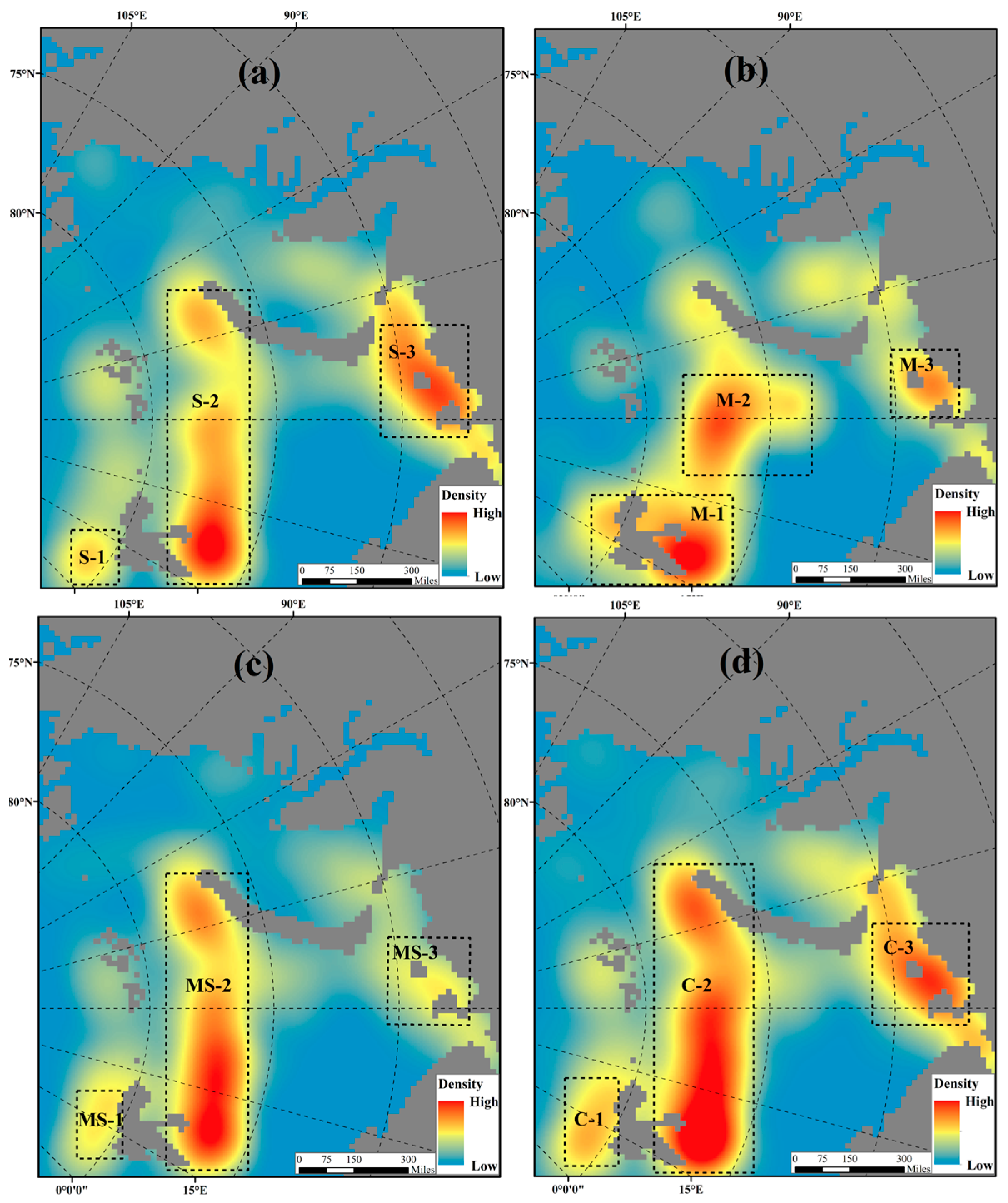

| Eps1 | 0.5 | 0.7 | 0.9 | 0.95 | 1 | 1.03 | 1.05 | 1.1 | 1.3 | 1.5 | 1.7 | 1.9 | |
|---|---|---|---|---|---|---|---|---|---|---|---|---|---|
| Minpts | |||||||||||||
| 3 | −0.25 | −0.60 | −0.47 | −0.47 | −0.44 | −0.28 | 0.47 | 0.47 | 0.47 | 0.47 | 0.47 | 0.47 | |
| 4 | −0.48 | −0.53 | −0.48 | −0.47 | −0.44 | −0.33 | 0.32 | 0.28 | 0.47 | 0.47 | 0.47 | 0.47 | |
| 5 | −0.52 | −0.57 | −0.49 | −0.49 | −0.45 | −0.43 | 0.03 | 0.30 | 0.28 | 0.47 | 0.47 | 0.47 | |
| 6 | −0.02 | −0.57 | −0.43 | −0.43 | −0.45 | −0.52 | −0.52 | 0.02 | 0.33 | 0.28 | 0.28 | 0.47 | |
| 7 | −0.03 | −0.60 | −0.45 | −0.43 | −0.46 | −0.46 | −0.43 | −0.31 | 0.28 | 0.37 | 0.37 | 0.37 | |
| 8 | null | −0.44 | −0.24 | −0.35 | −0.40 | −0.42 | −0.42 | −0.36 | 0.28 | 0.36 | 0.37 | 0.37 | |
| 9 | null | −0.43 | −0.23 | −0.37 | −0.47 | −0.51 | −0.42 | −0.42 | 0.33 | 0.31 | 0.25 | 0.37 | |
| 10 | null | −0.45 | −0.20 | −0.24 | −0.48 | −0.46 | −0.44 | −0.20 | −0.34 | 0.38 | 0.34 | 0.40 | |
| D-1 | D-2 | D-3 | D-4 | |
|---|---|---|---|---|
| O-1 | 45.45% | 9.09% | 27.27% | 18.18% |
| O-2 | 28.57% | 0.00% | 42.86% | 14.29% |
| O-3 | 41.67% | 16.67% | 16.67% | 16.67% |
| O-4 | 30.00% | 20.00% | 10.00% | 40.00% |
| O-1 | O-2 | O-3 | O-4 | |
|---|---|---|---|---|
| C-1 | 33.33% | 9.52% | 42.86% | 14.29% |
| C-2 | 17.07% | 12.20% | 56.10% | 14.63% |
| C-3 | 6.25% | 6.25% | 75.00% | 12.50% |
| D-1 | D-2 | D-3 | D-4 | |
|---|---|---|---|---|
| C-1 | 52.38% | 14.29% | 14.29% | 14.29% |
| C-2 | 41.46% | 12.20% | 21.95% | 17.07% |
| C-3 | 37.50% | 12.50% | 31.25% | 18.75% |
Disclaimer/Publisher’s Note: The statements, opinions and data contained in all publications are solely those of the individual author(s) and contributor(s) and not of MDPI and/or the editor(s). MDPI and/or the editor(s) disclaim responsibility for any injury to people or property resulting from any ideas, methods, instructions or products referred to in the content. |
© 2024 by the authors. Licensee MDPI, Basel, Switzerland. This article is an open access article distributed under the terms and conditions of the Creative Commons Attribution (CC BY) license (https://creativecommons.org/licenses/by/4.0/).
Share and Cite
Li, Y.; He, Y.; Liu, Y.; Jin, F. Analysis of Arctic Sea Ice Concentration Anomalies Using Spatiotemporal Clustering. J. Mar. Sci. Eng. 2024, 12, 1361. https://doi.org/10.3390/jmse12081361
Li Y, He Y, Liu Y, Jin F. Analysis of Arctic Sea Ice Concentration Anomalies Using Spatiotemporal Clustering. Journal of Marine Science and Engineering. 2024; 12(8):1361. https://doi.org/10.3390/jmse12081361
Chicago/Turabian StyleLi, Yongheng, Yawen He, Yanhua Liu, and Feng Jin. 2024. "Analysis of Arctic Sea Ice Concentration Anomalies Using Spatiotemporal Clustering" Journal of Marine Science and Engineering 12, no. 8: 1361. https://doi.org/10.3390/jmse12081361
APA StyleLi, Y., He, Y., Liu, Y., & Jin, F. (2024). Analysis of Arctic Sea Ice Concentration Anomalies Using Spatiotemporal Clustering. Journal of Marine Science and Engineering, 12(8), 1361. https://doi.org/10.3390/jmse12081361






